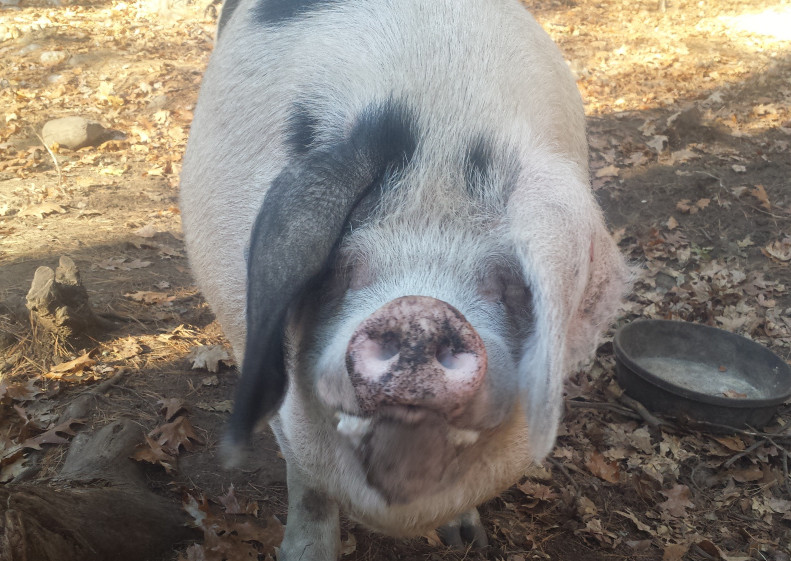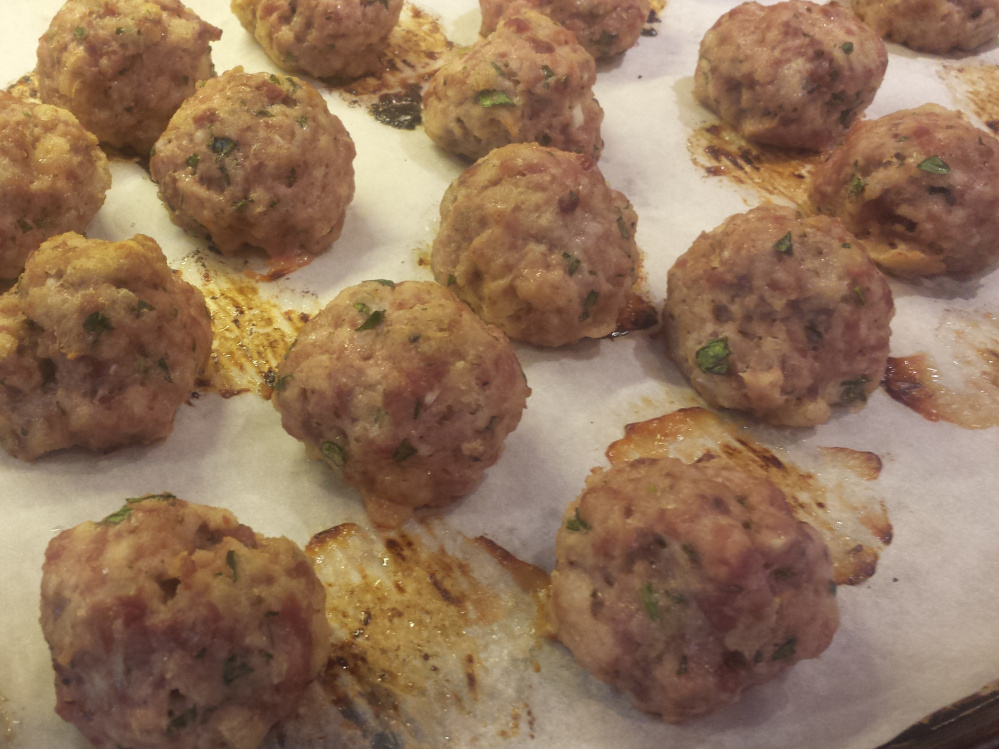Woodlot is to pork as grass-fed is to beef and free-range is to chicken.
Foraging has re-emerged as a trendy means by which chefs can put limited-edition seasonal dishes on their menus. But for heritage breed pigs like Large Blacks, Herefords and Gloucestershire Old Spots, digging for edibles is a traditional way of life. Letting these varieties of pigs out of their pens, where they do not thrive, to roam in rotating fenced-in areas of forest gives them the opportunity to feast on nuts and berries, uproot invasive plants, devour rotting tree stumps and rejuvenate the woodlot ecosystem.
“When they’ve had their fill, it looks like someone swept the forest floor,” said Seth Lewis, who has been breeding two Gloucestershire Old Spots, which are white with clearly defined black spots, on Blue Tin Farm in Edgecomb for three years.
Because the pigs can forage for food, his organic feed costs are kept to a minimum; the pigs will even dig for roots buried beneath a layer of snow, Lewis said, adding that they also happily consume agricultural byproducts like windfall apples in orchards and whey from cheese-making.
Wildlife specialists in Maine are skittish about the prospect of forest-raised pigs. If the pigs escape, they could form a feral population, as has happened with feedlot pigs with disastrous consequences elsewhere in the United States. In Georgia, for instance, extensive areas of the forest floor look like they have been plowed due to the pigs’ rooting behavior, explained Malcolm L. Hunter, professor of wildlife ecology at the University of Maine: “If that happens in a couple woodlots, it is one thing; if it spreads across the landscape, that is another.”
Lewis has a strong interest in both preventing his pigs from escaping and preserving the woods by his farm, so he takes precautions. No industry standards delineate how many pigs can root around how big a lot for how long without damage. But Lewis says experience has taught him that seven to eight 200-pound Gloucestershire Old Spots can eat down the green growth on 1 acre of forest, at which point they root around and eat bark off the trees. Before that happens, he moves them.
Lewis uses electrified fences to keep the pigs within their allotted acre. He said he’s had only one runner in three years, an escapee who was easily coaxed back with an apple. “They really don’t want to leave,” Lewis said. They are happy pigs.
As for the meat? “(The pork) is a beautiful, deep pink color, generously but not outrageously marbled,” said Blue Tin Farm customer Zora Margolis, also of Edgecomb. “You know how supermarket pork has hardly any flavor? This has really deep pork flavor.”
In addition to the flavor, Lewis chose to breed Gloucestershire Old Spots to help save them from extinction in North America. Brought over from England in the early 1900s to contribute genetically to breeds like the American Spot and the Chester White, the breed was in need of saving by 1995, when the Kelmscott Farm Foundation in Lincolnville imported 20 piglets from England to help re-establish the pure-bred population here. This year, the Livestock Conservancy moved Gloucestershire Old Spots from the “critically endangered” list to the less dire, “threatened” status.
Lewis raises his pigs for 8 to 10 months until they weigh about 300 pounds, which translates to about 140 pounds of meat.
As a pig nears maturity, customers put down a deposit on either a half or whole animal. At that point, customers specify how they want the animal processed (chops versus roasts, bacon versus belly, ground plain versus seasoned for sausages, etc.) and the rest of the money is due upon delivery. Lewis says the processing price varies based on customers’ choices (smoking and sausage making are extra), but the meat costs on average $10 per pound, which is about $3 per pound less than the price he charges at farmers markets.
“I no longer succumb to the siren song of cheap supermarket pork.… To support local farmers who raise animals humanely in a sustainable manner, I am willing to pay more and eat meat less frequently,” Margolis said, adding that she’s warmed by the thought of a freezer full of incredibly high-quality pork on hand to cook throughout the winter.
PORK AND RICOTTA MEATBALLS
My daughter Eliza has been on a meatball kick of late, answering “spaghetti and meatballs” every time I ask for a dinner request. So I tend to make a lot when I oblige her request, tucking half into the freezer for a later date. This recipe is adapted from one I found in Jennifer Pearsall’s “Praise the Pig.” The delicate seasonings let the taste of local pork shine through.
Makes about 40 golf ball-sized meatballs
2 pounds ground pork
1 pound Italian sausage
1 large bunch of flat-leaf parsley, minced
1 medium onion, grated
2 tablespoons minced garlic
1 tablespoon dried oregano
1 tablespoon salt
1 tablespoon cracked black pepper
2 cups fresh ricotta cheese
3 eggs, lightly beaten
2-3 cups fresh breadcrumbs
Oil for rolling meatballs
Preheat the oven to 375 degrees F and line 2 large baking sheets with parchment.
Use your hands to break up the meat into a large mixing bowl. Spread out the meat around the bowl to expose as much surface area as possible. Sprinkle parsley, onion, garlic, oregano, salt and pepper over the meat. Gently mix the herbs and spices into the meat. Add ricotta and eggs to the meat. Fold and squeeze the mixture until the ingredients are evenly distributed. The mixture will be quite gooey. Work 2 cups of bread crumbs into the mixture, adding more if necessary until you can form golf ball-sized meatballs that are not mushy or sticky. Coat your hands with oil and roll meatballs and place them 1 inch apart on the prepared baking sheets. Gently slide the baking sheets into the oven. Bake until the meatballs are lightly browned and glistening (20 to 30 minutes) and cooked through (their temperature should be 165 degrees) but not dry.
From here, you can add them to sauce and serve with pasta or cool them completely and freeze for future use.
Christine Burns Rudalevige is a food writer, recipe developer and tester, and cooking teacher in Brunswick. She writes about feeding her family Maine seafood at familyfish.net. Contact her at cburns1227@gmail.com.
Send questions/comments to the editors.




Comments are no longer available on this story